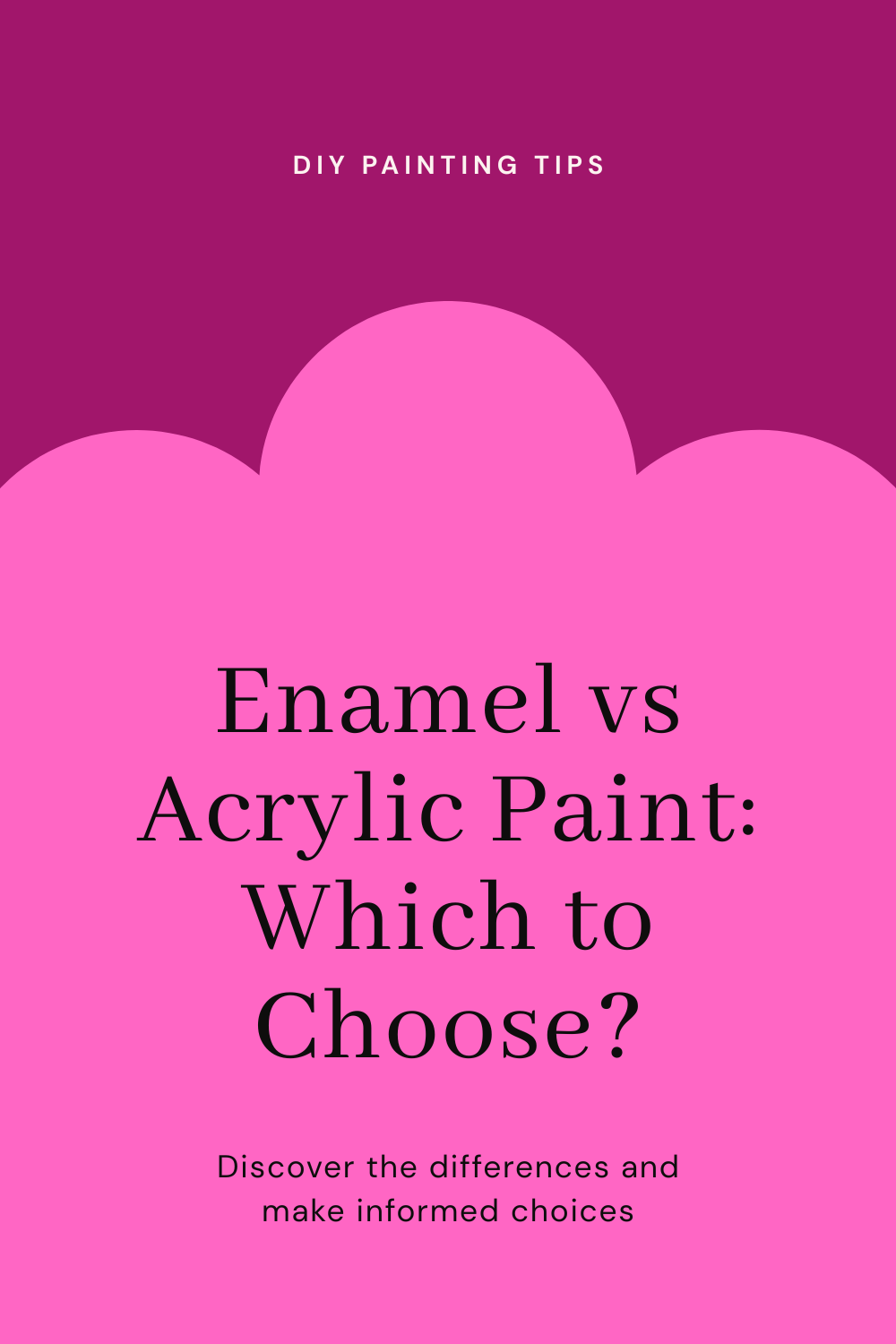Enamel vs Acrylic Paint
If you’ve ever walked into a home improvement store and found yourself staring at rows of paint cans, wondering which one is best for your project, you’re not alone.
The world of paint can be overwhelming, with a seemingly endless choice of options. Among the most popular types are enamel and acrylic paints, each offering unique benefits and considerations. So, how do you choose between them?
In this article, we’ll take a deep dive into the differences between enamel and acrylic paints, comparing their properties, ideal uses, and providing step-by-step guidance on when to use each one.
Whether you’re a DIY enthusiast or a professional painter, you’ll find the information you need to make an informed decision.
Enamel vs Acrylic Paint: What’s the Difference?
What’s the Big Deal?
At first glance, enamel and acrylic paints might seem similar both are designed for various surfaces, and both provide a durable finish.
However, they have significant differences that can affect the outcome of your project. So, let’s take a closer look at the core differences between these two types of paints and how to use them effectively.
Enamel vs Acrylic Paint Comparison
| Feature | Enamel Paint | Acrylic Paint |
| Composition | Oil-based or alkyd-based | Water-based |
| Drying Time | Slow (8-24 hours) | Fast (1-2 hours) |
| Durability | Extremely durable, resistant to wear and tear | Less durable, can chip or fade over time |
| Finish | Glossy or semi-glossy | Matte, glossy, satin, or semi-gloss |
| Application | Requires mineral spirits for cleanup | Soap and water cleanup |
| Best for | High-traffic areas, outdoor furniture, metal | Indoor surfaces, crafts, murals, woodwork |
| Odor | Strong, lingering odor | Low odor |
| Environmental Impact | Less eco-friendly (contains solvents) | More eco-friendly, water-based |
| Cost | More expensive | Generally more affordable |
Enamel Paint: The Classic Choice for Durability
When it comes to a high-gloss finish and long-lasting durability, enamel paint is often the go-to choice. But what exactly makes enamel paint so durable?
Enamel paint is an oil-based or alkyd-based product, meaning it contains solvents and oils that give it a glossy, smooth finish. This makes it ideal for high-traffic areas and projects that require a tough, long-lasting surface. The most common uses for enamel paint are on metal surfaces, such as doors, windows, and outdoor furniture. It’s also perfect for automotive applications due to its hard finish.
Advantages of Enamel Paint:
- Longevity: Enamel paint is resistant to wear and tear, which makes it a great option for surfaces that see a lot of action.
- Glossy Finish: Enamel delivers a shiny, smooth finish that can make surfaces look sleek and polished.
- Weather Resistance: Enamel paint holds up well to outdoor conditions, including rain and humidity, making it ideal for exterior surfaces.
Best Applications for Enamel Paint:
- Metal Furniture: If you’re looking to paint metal furniture for your garden or patio, enamel paint is a great option.
- Outdoor Fixtures: It’s perfect for painting outdoor light fixtures, railings, or fences because of its weather-resistant qualities.
- Automotive: Enamel is often used for painting cars, bikes, and other vehicles because it’s tough and long-lasting.
Acrylic Paint: The Versatile, Fast-Drying Option
Acrylic paint, on the other hand, is water-based, making it a versatile and eco-friendly choice for a variety of surfaces. One of the standout features of acrylic paint is its quick drying time—this means you can apply multiple coats in a single day. Unlike enamel paint, which has a slow drying time, acrylic paint dries within an hour or two, making it ideal for projects that require faster results.
Advantages of Acrylic Paint:
- Fast Drying: If you’re someone who hates waiting for paint to dry, acrylic paint is your best friend.
- Easy Cleanup: Because it’s water-based, you can easily clean brushes and tools with soap and water.
- Non-toxic: Acrylic paints are low in volatile organic compounds (VOCs), making them less harmful to the environment and safer for indoor use.
- Versatile: Acrylics can be used on a variety of surfaces, including canvas, wood, and paper, and they can even be mixed with other mediums like gesso and gels for different textures.
Best Applications for Acrylic Paint:
- Home Décor: Acrylics are perfect for interior projects, including wall paintings, crafts, and even furniture.
- Canvas and Paper Art: Artists favor acrylic paints for their flexibility, allowing for a wide range of techniques, from thick impasto applications to thin washes.
- Wood and Furniture: If you’re restoring furniture or creating a custom look for your home, acrylic paint offers a fast and durable finish.
Choosing Between Enamel and Acrylic Paint: Which One Should You Use?
Now that we’ve discussed the main characteristics of both enamel and acrylic paints, let’s break down how to choose between them.
Step 1: Consider the Surface
Start by thinking about the surface you’re working on. Enamel is often best for metal, high-traffic areas, and exterior projects, while acrylics are more suitable for wood, canvas, and indoor furniture.
Step 2: Think About Durability
If you’re working on a surface that needs to withstand heavy use or outdoor elements, enamel’s durability might be your best bet. If you’re painting something more decorative or an interior piece, acrylic may offer the versatility you need.
Step 3: Drying Time and Application
Acrylic paint’s quick drying time makes it a convenient option for those in a rush. Enamel, on the other hand, requires more patience due to its slow drying time but pays off with a high-gloss finish that’s hard to beat.
Step 4: Environmental Concerns
If you’re environmentally conscious, acrylic paint wins. It’s a water-based product with minimal odors and fewer harmful chemicals, whereas enamel can emit strong fumes and often contains solvents.
Common Mistakes to Avoid
When it comes to both enamel and acrylic paints, there are a few common mistakes that can negatively impact your project. Here are some to watch out for:
- Not Preparing the Surface: Whether you’re using enamel or acrylic, it’s important to properly prep your surface before painting. Failing to clean or sand the surface can lead to poor adhesion and an uneven finish.
- Using the Wrong Primer: Enamel paints typically need a specific primer to adhere properly, especially on metal surfaces. Acrylic paints can often work without a primer, but using one can help achieve a smoother finish.
- Rushing the Drying Time: With enamel, you might be tempted to apply a second coat before the first one has fully dried. This can lead to streaks, bubbling, and uneven coverage. Acrylic paint dries quickly, but rushing to apply a second coat too soon can result in poor adhesion and cracking.
- Not Ventilating the Area: Enamel paints often have strong fumes due to their solvent content. If you’re painting indoors, be sure to ventilate the area well to avoid inhaling harmful chemicals.
Step-by-Step Guide: How to Apply Enamel and Acrylic Paint
Here’s a simple step-by-step guide for applying both types of paint.
How to Apply Enamel Paint:
- Prepare the Surface: Clean the surface thoroughly to remove dirt and grease. Sand the area lightly if needed.
- Prime the Surface (if needed): Use a primer designed for enamel paint. For metal surfaces, an anti-rust primer may be necessary.
- Apply the Paint: Use a high-quality brush or roller designed for enamel paints. Apply an even coat and allow it to dry for the recommended time.
- Apply Additional Coats: If needed, apply a second coat after the first coat is completely dry.
- Cleanup: Use mineral spirits or paint thinner to clean your tools.
How to Apply Acrylic Paint:
- Prepare the Surface: Clean the surface with soap and water. Lightly sand if the surface is rough.
- Prime the Surface (if needed): For best results, use an acrylic-specific primer.
- Apply the Paint: Use a soft brush or roller to apply the paint. Start with a thin layer and gradually build up.
- Allow the Paint to Dry: Acrylic paint dries quickly, but be sure to give it enough time between coats.
- Cleanup: Wash your brushes and tools with soap and water immediately after use.
Conclusion: Which Paint is Right for You?
So, which one should you choose? It all comes down to your project’s needs. If you’re looking for something that can stand the test of time and tough conditions, enamel might be your best bet. But if you’re working on a more decorative project, need fast results, or are working indoors, acrylic paint could be the ideal choice.
Key Takeaways:
- Enamel is oil-based and offers durability and a glossy finish, ideal for metal and outdoor projects.
- Acrylic is water-based, quick-drying, versatile, and environmentally friendly, perfect for indoor projects and crafts.
- Choose the paint type that best matches your surface, durability requirements, and environmental concerns.




